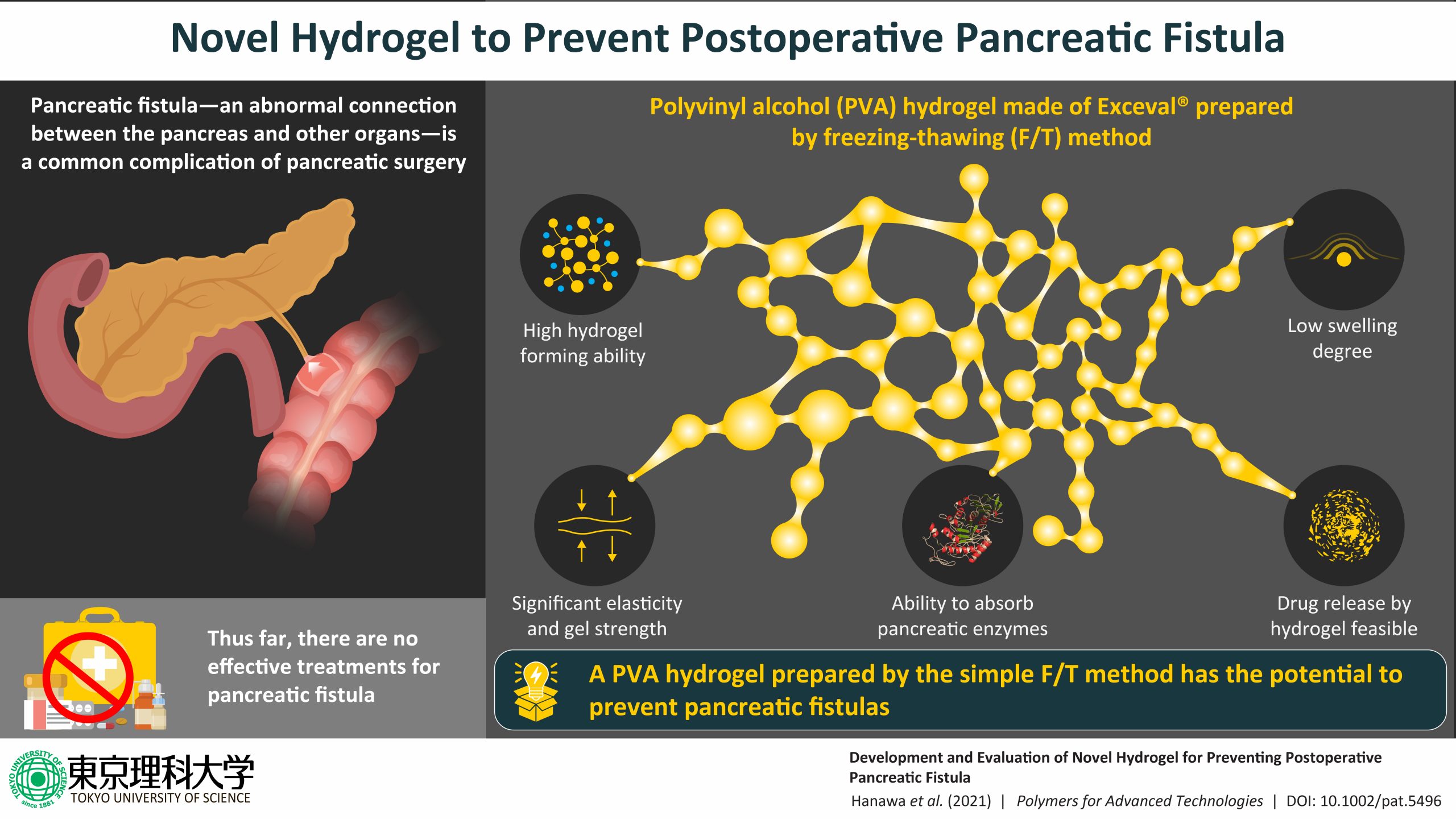Scientists have developed a polymer-based hydrogel that can prevent pancreatic fistulae, a frequent complication of pancreatic surgery.
An unnatural connection between the pancreas and adjacent organs, called a pancreatic fistula, is a common complication of pancreatic surgery. This condition can lead to infection, sepsis and in some cases be fatal. So far, there are no effective methods that can stop these fistulae from developing after surgery. But, now, a team led by researchers from
Tokyo University of Science have developed a novel hydrogel that can prevent pancreatic fistulae and thus, save lives.
Pancreatic fistulae, or ducts that grow from the pancreas to nearby organs such as the colon, are a frequent complication after pancreatic surgery. Studies have shown that the risk of pancreatic fistulae after surgery is as high as 50%. These fistulae cause a leakage of pancreatic fluid, which can then accumulate near the pancreas and form an abscess, become severely infected, and—in severe cases—lead to death. Repairing these fistulae is also a prolonged and complex process. They say prevention is better than cure, but despite multiple attempts, there are currently no effective prevention methods for pancreatic fistulae.
In a recent study, a team of scientists—including Professor Takehisa Hanawa, Dr. Yayoi Kawano and Mr. Hiroshi Mamada from Tokyo University of Science, as well as Dr. Akira Kemmochi and Dr. Takafumi Tamura from the University of Tsukuba—have developed a novel hydrogel that can prevent the formation of these postoperative pancreatic fistulae. The study was published in Polymers for Advanced Technologies.
“There are many polymers with chemical or biological synthesis, but their preparation and application can be somewhat complicated. Our research was inspired by a desire to develop a hydrogel that can be used simply and effectively in surgical settings as one of the ‘Patient-Friendly Formulations,’” says Prof. Hanawa.
Like the name suggests, hydrogels are three-dimensional polymer networks that can hold a large amount of water. This makes them useful in a wide variety of fields, from agriculture to wound healing in medicine. These hydrogels can be prepared in one of two ways. One, using chemical techniques such as chemical reactions or electron beam crosslinking, and the other using physical methods such as the freezing-thawing (F/T) cycle method. The polymer solution is prepared and then frozen, which makes the water present in the solution gather as ice. This allows the hydrogel particles to link together. The solution is then thawed and frozen again until the desired level of linkage is achieved in the hydrogel.
In this study, the research team prepared two polyvinyl alcohol (PVA) hydrogels using of two types of PVAs, Poval® and Exceval®. They then studied then evaluated a critical hydrogel property called swelling behavior. Hydrogels absorb water, which makes them swell. This swelling can at times cause the hydrogel to rupture. They found that the Exceval® hydrogel showed a lower swelling degree, increased elasticity, and superior gel strength to the one made with Poval®. These properties implied that the Exceval® could potentially be used in the abdominal cavity after pancreatic surgery.
The research team then prepared hydrogels that contained tartrazine, a common dye used to study the drug-release behavior of hydrogels, and nefamostat mesylate (NM), a drug that is used to treat pancreatitis. They found that the drug-release behavior of both hydrogels depended on the number of F/T cycles used in their preparation.
Finally, the research team tested the hydrogel in vivo in a pancreatic fistula rat model. They found that rats with the hydrogel showed lower levels of pancreatic enzymes in the blood and abdominal fluid, indicating that the leakage of pancreatic fluid was controlled. They inferred that the hydrogel was capable of absorbing pancreatic juices and intra-abdominal fluid, and of preventing pancreatic fistula.
The research team mentions that the results of animal experiments using the gel prepared in this study have been published in the Journal of Hepato-Biliary-Pancreatic Sciences.
“Since the hydrogel prepared in this study also has the ability to absorb liquid, we believe that it can be applied, not only to the body, but also to cancerous skin ulcers and wounds, where it can absorb secretions and release medicines for treatment,” explains Prof. Hanawa.
With its adjustable properties, excellent swelling behavior and high absorption abilities, the novel Exceval® hydrogel shows great promise for clinical applications for the prevention of pancreatic fistulae.
***
Reference
Title of original paper: Development and evaluation of novel hydrogel for preventing postoperative pancreatic fistula
Journal: Polymers for Advanced Technologies
DOI:
https://doi.org/10.1002/pat.5496 